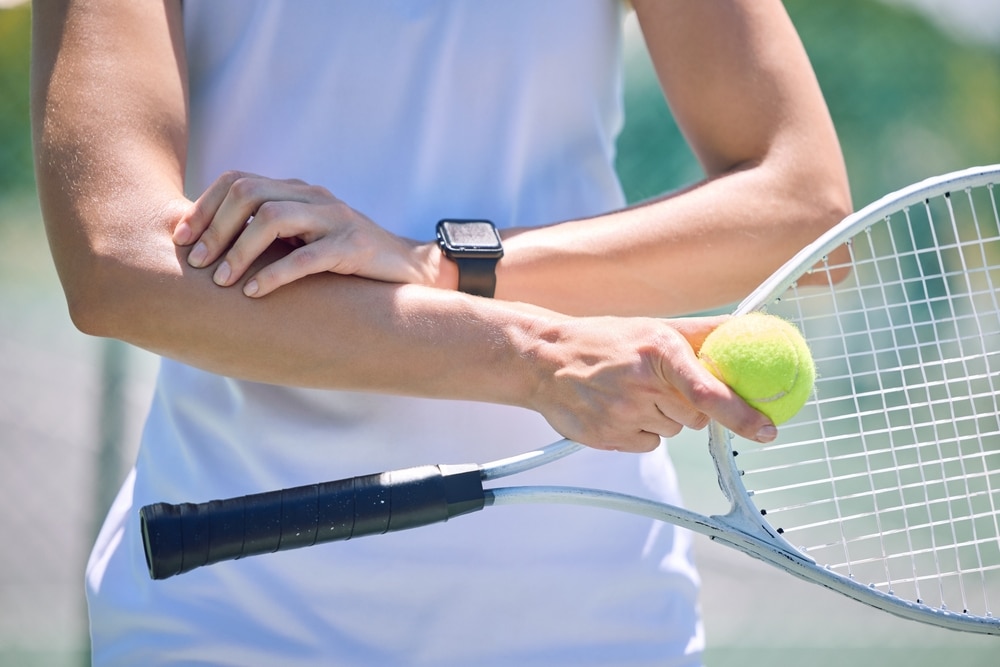Table of Contents
What sport is there without some health checkups and concerns. Right? Same is the case with tennis game. Now, some tests go by the name of tennis elbow test that you need to make sure of especially if you’re a professional player. But, you must be wondering what a tennis elbow test is? A tennis elbow test checks for lateral epicondylitis, or tennis elbow, by applying pressure to the outer elbow while you resist wrist or finger extension. Pain in this area during the test may indicate tennis elbow, helping confirm the diagnosis. Now, the Internet is great, and several elbow tests are available for ease and comfort. Let us see why this pain is caused and why we need to take the test.
Elbow Pain Caused by Tennis
Does the pain caused by tennis elbow interfere with your everyday activities? Don’t worry; help might be closer than you think. It is time to take matters into your own hands and test yourself if you feel that telltale soreness around the elbow. You can determine if you have the infamous lateral epicondylitis by completing nine simple tennis elbow tests. All degrees of discomfort are seen by these diagnostic approaches, which range from the classic palpating method to the popular Cozen’s Test. Your body is the key to knowing what it needs, whether grabbing your morning cup of coffee or gripping a racket. Therefore, resist the urge to let your pain win you over. Seize the chance to investigate and confront your symptoms head-on. Take a tennis elbow test now, and feel confident about regaining your range of motion. Your forearms will truly appreciate it.
9 Special Tests for Tennis Elbow
Let us take a look at these special kinds of elbow tests designed for tennis elbow.
Palpating
Palpating the lateral epicondyle, which requires careful examination to find any pain, tenderness, or swelling, is an important part of diagnosing tennis elbow.
- Positioning: Sit with your palm facing up and your forearm extended on a table.
- Finding the Area: The lateral epicondyle is the bony protrusion outside the elbow.
- Light Pressure: Using your fingers or thumb, lightly push the region surrounding the lateral epicondyle.
- Observation: During palpation, record any discomfort, soreness, or swelling you feel.
- Repetition: Repeat the procedure while adjusting the pressure to determine the area’s sensitivity.
The Coffee Cup Test
Tennis elbow diagnosis is done frequently with the Coffee Cup Test, a diagnostic technique.
- Patients score their pain level when doing routine tasks like holding a carton of milk or coffee.
- These movements stress the tendons that the tennis elbow impacts, making them sensitive pain markers.
- Medical practitioners use the test to determine the severity of the ailment and modify treatment methods accordingly.
- It provides a useful and simple means of determining pain thresholds and tracking recovery throughout rehabilitation.
Because of its ease of use, the test can be used by individuals and medical professionals to effectively manage tennis elbow.
Resistance
Tennis elbow, a painful ailment affecting the tendons in the elbow, is frequently diagnosis done by resistance testing. This test requires certain motions to evaluate the tendons’ strength and integrity. Resistance testing operates as follows.
- The injured arm should be extended straight out in front, palm down.
- Lay the other hand behind the outstretched hand.
- Try to bend the bottom wrist backward while applying pressure with the upper hand.
- Resistance is achieved by applying pressure with the upper hand to the lower. This allows one to assess how much pain or weakness was present during the exercise.
Resistance testing is a useful tool medical professionals use to assess the severity of tennis elbow and create a personalized treatment plan that may involve physical therapy, rest, or other therapies to reduce symptoms and accelerate healing.
Middle Finger Resistance
The middle finger resistance tennis elbow test is a diagnostic technique to evaluate the strength and integrity of the muscles and tendons linked to tennis elbow or lateral epicondylitis. This test calls for certain exercises to assess the resistance and pain response in the affected area.
- With the palm facing up, extend the afflicted arm straight out.
- Use the opposing hand to bring the middle finger back toward the forearm.
- The person should give the middle finger in opposition to this motion at the same time.
- Turn the hand palm down.
- While fighting the urge to move the middle finger downward, apply pressure.
By assessing pain levels and resistance capacities during these motions, this test assists physicians in determining the existence and severity of tennis elbow, which aids in developing an effective treatment plan.
Chair Pickup Test
The Chair Pickup tennis elbow test is a quick and easy way to determine whether someone has tennis elbow or lateral epicondylitis. This exam focuses on the forearm extensor muscles, frequently impacted by the tennis elbow.
- Place a light chair in front of you and stand.
- Straighten your affected arm out in front of you.
- Rotate your wrist so that your fingers point down.
- Apply pressure with your thumb, index finger, and middle finger on the back of the chair.
- When you raise the chair off the ground, maintain a straight arm.
This test aids in diagnosing tennis elbow by evaluating the extensor muscles’ strength and pain threshold. It’s a quick and useful tool for healthcare professionals assessing this frequent condition.
Mill’s Test
The Mill’s Test is carried out to identify lateral epicondylitis, also known as tendinitis elbow.
- The patient sits with their wrist straight, and their afflicted arm extended.
- The doctor fully flexes and bends the patient’s wrist forward.
- Next, the physician palpates the lateral epicondyle while rotating the patient’s forearm inward.
- If pain is felt in the lateral epicondyle region during this maneuver, a positive test result for lateral epicondylitis is indicated.
The Mill’s Test aids in diagnosing tennis elbow by applying force to the tendon connection at the lateral epicondyle. It’s essential for differentiating elbow pain-causing disorders from lateral epicondylitis.
Cozen’s Test
This tennis elbow test is a diagnostic technique used to evaluate for lateral epicondylitis, widely known as tennis elbow. It is also called the resistive tennis elbow test or the resisted wrist extension test.
- The individual raises their afflicted arm to make a fist in front of them.
- The wrist is bent toward the forearm as the forearm is rotated inward.
- The physician provides resistance as the patient tries to move the wrist into dorsal flexion.
- During the resisted movement, the physician closely inspects the lateral epicondyle to look for indications of pain or discomfort.
- The test is considered positive when pain is felt at the lateral epicondyle during the resisted wrist extension.
When diagnosing tennis elbow, Cozen’s test is a straightforward but useful clinical diagnostic accuracy that aids medical professionals in determining the cause of lateral epicondylar pain.
Golfers
A physical examination method called the Golfers Tennis Elbow Test, or medial epicondylitis test, is used to determine whether medial epicondylitis, sometimes referred to as golfer’s elbow, is present.
- The examiner lays one hand on the common flexor tendon or medial epicondyle.
- The examiner passively pronates the forearm wrist and extends the elbow with the opposite hand.
- Pain or discomfort at the medial epicondyle or common flexor tendon indicates a positive test.
- This test aids in diagnosing the golfer’s elbow, a condition marked by irritation or inflammation of the tendons that join the inner elbow to the forearm muscles. It can produce pain and tenderness in the affected area and is frequently brought on by repetitive activities like swinging a golf club.
Hook Test
In cases of suspected rupture or damage, the Hook Test, often called the Tennois Test, is a clinical test used to determine the integrity of the biceps tendon.
- The patient must fully supinate their forearm and flex their elbow to a 90° angle.
- The examiner then hooked the lateral edge of the biceps tendon using their index finger.
- An examiner usually gets their finger about 1 cm below the tendon in a healthy bicep’s tendon.
- When a biceps tendon ruptures completely, the examiner won’t locate any structure that resembles a cord to loop their finger beneath.
- It is important to interpret partial tears cautiously because aberrant results in this test may not always accompany them.
The Hook Test is an invaluable clinical tool for assessing biceps tendon injuries. It can help with timely management and treatment decisions.
Final Thoughts
Summing up, one can understand tennis elbow better by adding to this examination resisted wrist extension, palpation of the lateral epicondyle, and possibly using Cozen’s or Mill’s tests. Don’t worry; with this precise diagnosis, you can confidently pursue customized physical therapy methods, such as extensor carpi radialis brevis muscle workouts for radial deviation.
In conclusion, use these tests as an asset for making well-informed decisions, and you can find that the way to relief becomes more apparent.
LET YOUR ELBOWS APPRECIATE YOUR GAME!





